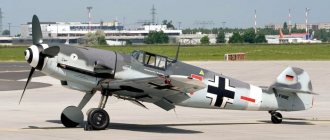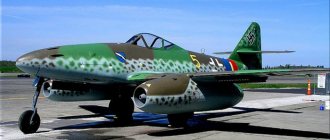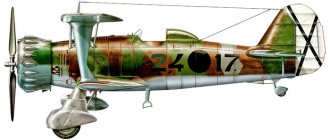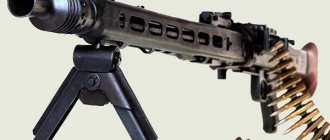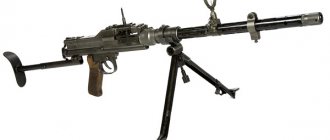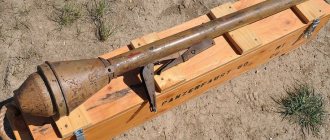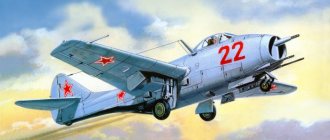« Brief information : German heavy twin-engine fighter Messerschmitt Me-210 (Me-410). Combat use, full characteristics, information about modifications and drawings"
The Messerschmitt Me-410 is a real, “thoroughbred” fighter in its appearance alone
The history of the creation of the Me-210 fighter
By 1938, the Messerschmitt Bf-110 heavy fighter could no longer be considered a modern and universal machine capable of solving the entire range of combat missions assigned to it. For this reason, at the end of 1938 (October), the task was also set to create the so-called “hunter” - a new heavy fighter.
While retaining the general features of the Bf-110, as well as its power plant, the future heavy fighter Me-210 was supposed to have greater speed, have all the capabilities of a full-fledged bomber, and have more solid defensive weapons.
The work was carried out in a hurry - the deadline set by the customer was set as October of the following year, 1939. It got to the point that it was decided to send the aircraft, which had not even approached the testing stage, into mass production. Meanwhile, the heavy fighter had enough problems.
Due to the presence of a bomb bay, it was necessary to increase the volume of the fuselage, and therefore the fuel supply. Following this, the need arose to strengthen the structure, and to improve controllability, to lengthen the fuselage and wings... However, V. Messerschmitt “cut down” any attempts to lengthen parts of the aircraft (the engines, let me remind you, remained like those of the “low-speed” Bf-110) because of which The company even fired the head of the design department, R. Lyusser, who predicted such an aircraft would not have a long combat career.
Drawing of the Messerschmitt Me-410 heavy fighter
As a result, Messerschmitt met the deadline - the Me-210V-1 prototype took off from the ground in the fall. The very first flights confirmed the correctness of all Lusser’s comments - the car in the air was unstable on all axes and strove to go into a tailspin. A solution was immediately thought of - installing a large-area single-fin tail, but the problem was only reduced, but not solved. And the shortcomings surfaced one after another, and each one required time to eliminate.
When all the terms of the contract expired, in May 1941, the Me-210 was still a “raw” machine, but under pressure from the Reich Ministry of Aviation, they even managed to put it into production and built 200 aircraft (another 300 remained unfinished), until April 14 In 1942, a decision was not made to stop production of this unsuccessful Messerschmitt machine in every sense - the company lost 30 million Rechsmarks on this contract, and V. Messerschmitt himself was removed from the post of managing director of the company.
The defeat had a sobering effect. Having reworked the design, lengthening the tail of the aircraft by 90 cm and installing slats, on March 14, 1942, the modified Me-210V17 . This time everything went perfectly - the car no longer fell into a tailspin and obeyed the steering wheel perfectly. Immediately, all “half-finished” samples of the Me-210 began to be redesigned in the image of the Me-210V17, and in order to erase the memory of the unsuccessful start to the career of a heavy fighter, all new vehicles received new indices - Me-310 (high-altitude, which remained in the project) and Me- 410 .
The Me-410 differed from the Me-210V17 by new DB-603 engines, a wing with a reduced leading edge sweep, modified radiators and a modified flap shape. More than 20 prototypes took part in the tests, which began in the fall of 1943. Serial production began in January 1943 at the Augsburg plant. In December she joined production.
Production of the Me-410 was carried out in Augsburg and Regensburg, MIAG in Braunschweig, Dornier Werke in Friedrichshafen, and continued until September 1944 (in Hungary, the Me-210 was produced under license until December 1944). During this time, a total of 1,696 fighters of both models were manufactured.
German heavy fighter Messerschmitt Me-210 (Me-410)
Design of the Me-210 (Me-410) heavy fighter
The Messerschmitt Me-410 fighter is made according to the aerodynamic design of a cantilever low-wing aircraft of an all-metal structure, with working skin. The wing is single-spar, straight, trapezoidal in plan.
The landing gear is retractable, tricycle with a tail wheel. The main racks retract back by turning 90 degrees.
The power plant consists of 2 DB-603 water-cooled V-shaped piston engines with three-blade variable-pitch propellers. The fuel supply was located in 6 protected wing tanks.
The cockpit is covered by a common canopy and is located in the forward part of the fuselage. The pilot and gunner-radio operator sit with their backs to each other, their seats have armor protection.
Heavy fighter
Messerschmitt
The urgent need to replace the obsolete Me-110 and unsuccessful Me-210 in the Luftwaffe combat squadrons was the reason for the creation of a new twin-engine heavy fighter. It was decided to develop this aircraft on the basis of the Me-210 so that it would be possible to use existing technological equipment and prepared parts and components. In addition, this approach made it easier for the flight crew to master the new aircraft.
The Me-210 fighter was used to develop the Me-410 in the literal sense of the word: six production Me-210 variants A-1 and A-2 were taken and converted into a new aircraft; At the same time, the length and midsection of the fuselage were changed, significant changes were made to the wing design and the installation of forced 12-mm cylinder engines DB-603A-1 with a power of 1850 hp was provided. (prototypes of the Me-410 flew with DB-601 engines).
Tests of the Me-410 were carried out in the fall of 1942, and already in December of the same year, serial production of the first modification of the Me-410A “Hornisse” (Hornisse - hornet) began in Germany and at the Danube Aircraft Plant in Hungary. At the same time, the production of the Me-110 was maintained not only out of unwillingness to take risks, but also due to the fact that the Me-410 did not have any fundamental advantages over this outdated aircraft.
The main differences between the Me 410 and the Me 210 V17 were the new powerful DB 603 engines with 1850 hp. at an altitude of 2700 m, with 5° less sweep of the leading edge of the wing consoles and slats. In addition, the aerodynamics of the radiators were somewhat improved and the shape of the flaps was changed. The closeness of the design to the Me 210 made it possible to withdraw the first Me 410 from the workshop just 9 months after the decision to cease mass production of its predecessor. This was a converted Me 210A-0 (No. 27), which entered flight testing in the fall of 1943. In total, the unprecedented Me 410 test program involved more than 20 prototype aircraft, mostly converted from the Me 210A and six more aircraft with old DB engines 601F.
The controllability of the new “hunter” has now returned to normal, although due to more powerful engines it has become worse than that of the Me 210 with an extended fuselage, and, most importantly, the flight data of the Me 410 finally turned out to be higher than that of the Bf 110 (in mainly due to new engines). The internal suspension of bombs on the Me 410 allowed it to maintain a higher speed when performing bomber missions compared to the “one hundred and tenth” - the latter by that time (1942-43) was used on the war fronts almost exclusively as a “high-speed bomber”. All this made it possible to make the decision to begin mass production of the Me 410 in two versions: Me 410A-1 - “schnellbomber” and Me 410A-2 - “hunter”.
Power point
The Me 210 was equipped with a pair of 12-cylinder inverted V-shaped in-line engines DB 601F with a power of 1005 kW (1350 hp), and the Me 410 had stronger and more modified DB 603A power plants with a power of 1300 kW (1750 hp). ). For the Me 410B, the DB 603G was used, whose high-speed supercharger and increased compression ratio made it possible to increase power to 1415 kW (1900 hp).
The main problems of the Me 210 were resolved before mass production began, so the Me 410 turned out to be much more successful, since it was basically a modification of the Me 210 with improved engines and all the necessary modifications. Controllability has improved, takeoff has improved, and the tendency for the plane to suddenly stall into a tailspin has disappeared.
Armament
In the standard version, the weapons of the Me-410 did not differ from the weapons of the Me-210. These were two 7.92-mm MG-17 machine guns and two 20-mm MG-151/20 cannons installed fixed in the forward part of the fuselage, as well as two 13-mm MG-131 machine guns in movable rifle installations - blisters installed on both the sides of the fuselage behind the trailing edge of the wing.
The bomb bay was located at the bottom of the bow under the cockpit. The aircraft could carry two bombs weighing up to 500 kg, which were suspended from a lower holder and then retracted into the bomb bay.
The Me-410 was in mass production until September 1944, when the factories producing it were finally destroyed by Allied bomber aircraft. A total of 1,160 (according to other sources - 1,013) aircraft of this type were produced. In less than two years, German designers managed to develop four main modifications (A, B, C and D) and about thirty different options.
Me-410B-2 being tested at the Air Force Research Institute.
Back in June 1944, our specialists studied turret installations that were used in aviation in Italy and Great Britain. Germany based on materials published by our allies. According to the conclusions of engineer E.M. Peisakhovich, “to effectively protect bombers, the Germans and Italians used mobile installations for one or two 12.7-13 mm heavy machine guns, which increased their protection from attacks by modern fighters.” In these mobile installations, manual control was replaced by a mechanical drive, and the most interesting were remote-controlled turrets, which made it possible to rationally position both weapons and shooters.
Peysakhovich believed that the most successful solution was the creation in Germany of remote onboard machine guns FDSL-B131, providing aiming in the vertical plane with angles of ±72° and with horizontal aiming from -3° to +48° from the axis of the Me 210 aircraft. Such an installation provided better protection of the vehicle than the movable machine gun on the Bf 110. The control unit was a pipe on which the weapon aiming control was mounted, with electric-pneumatic charging and electric triggering. The pipe was installed at the eye level of the radio operator. On both sides there were Revi 25B sights, into which corrections were made for the aircraft’s own speed.
The Me 210 was not used by the Germans on the Eastern Front and, therefore, Soviet gunsmiths did not have the opportunity to test the effectiveness of the remote installation. When the Me 410B-2 from Group II/ZG26 (serial number 130379) was captured after the war, the aircraft was thoroughly tested (leading engineer - Lieutenant Colonel V.Ya. Magon, pilot - Major I.P. Piskunov). Indeed, the design of the FDSL-B131 remote airborne machine gun mount turned out to be very successful: convenient and trouble-free in operation.
The phrase formulated by the leadership of the Air Force Research Institute in the test report: “Individual structural elements and units of the propeller-engine group, weapons and special equipment are of technical interest and should be the subject of study by the design bureaus of the People's Commissariat of the Aviation Industry,” can be considered typical when assessing captured aircraft at the final stage war. As for the German remote installations, part of their experience was used in modifying the domestic mobile turrets of the Daewoo (for the UBK machine gun) on the Pe-2I and VU-5-20 (for the UB-20 cannon) on the Pe-2M (both vehicles designed by V. M. Myasishcheva).
The special equipment of the Messerschmitt was not fundamentally different from that used on other German vehicles and by 1945 it was generally well studied. Its placement, as noted in the Me 410 test report, provided a convenient approach to individual units and facilitated the operation of the aircraft. The quality of installation of instruments, electrical mechanisms, and electrical wiring remained high until the end of the war, which greatly contributed to the trouble-free operation of special equipment. Very successful DC tachometers, oxygen devices and lung valves were recommended for reproduction by domestic factories of a similar profile.
During a tactical assessment of the Me 410, engineer Lieutenant Colonel Magon noted that, being inferior in speed and maneuverability to modern Soviet fighters Yak-3, Yak-9U, La-7, the Messer cannot conduct an offensive air battle with them except by attacking oncoming courses. At the same time, for all types of domestic serial bombers, including the Tu-2, the Me 410B-2 posed a significant danger due to the high characteristics of the maximum speed of 600 km/h at an altitude of 6750 m, the climb time to 5000 m 8.6 minutes, and also powerful offensive weapons, consisting of two standard 20-mm MG-151 cannons and a 50-mm semi-automatic VK-5, firing a second salvo of 4.65 kg.
German designers thought through ways to best utilize the firepower of the Me 410B-2.
To do this, the twin-engine fighter was equipped with a combined sight, consisting of a telescopic tube, which gives an almost fourfold increase in objects visible through it, and a collimator. This made it possible to conduct targeted shooting at distances of 1000 m and more, where 50-mm high-explosive fragmentation shells could cause destructive damage to the structural elements of “pawns”, “silts”, “Bostons” and other vehicles. A German pilot could theoretically shoot down enemy planes while remaining out of range of defensive fire (although, of course, hitting a modern bomber from a distance of 800-1000 m was only possible by accident). Characteristics Me 410A-2/U4
| Crew | 2 people | |
| Dimensions. | ||
| Wingspan, m | 16.35 | |
| Length, m | 12.48 | |
| Height, m | 4.28 | |
| Wing area, m² | 36.2 | |
| Power plant 2xDB603A | ||
| Power hp | takeoff | 1750 |
| at an altitude of 2100 m | 1850 | |
| Flight data | ||
| Maximum speed, km/h | above sea level | 507 |
| at an altitude of 6700 m | 624 | |
| Max cruising speed, km/h | 587 | |
| Flight range, km | 1690 | |
| Weights and loads, kg: | ||
| Empty plane | 7518 | |
| Empty loaded | 9651 | |
| Armament | ||
| 2X20-mm MG-151 cannons with ammunition, pcs. | 2Х350 | |
| 4X7.9 mm MG-17 machine gun with ammunition, pcs. | 4X1000 | |
| 2X13-mm FDSL machine gun with ammunition, pcs. | 2Х500 | |
The design of the Me 410 aircraft differed from the Me 210:
- reduced sweep of the leading edge of the wing consoles by 5°;
- installation of automatic slats of the Handley-Page type on the leading edge of the wing consoles;
- modified shape of ailerons and flaps;
- modified fuselage due to lengthening of the tail section;
- The mechanism for opening the bomb bay flaps was equipped with a hydraulic drive:
- the use of two Daimler-Benz DB 603 A engines with a take-off power of 1750 hp in the aircraft’s propeller engine installation. With:
- improved aerodynamics of engine oil coolers:
Aircraft modifications
- Me-410A is the first production modification with DB-603A engines. There were options:
- Me-410 A-1 is a high-speed bomber, maximum flight speed is 624 km/h, bomb load is 1000 kg. There was a version of the Me-410A-1/U-4, armed with a 50-mm VK-5 cannon with a rate of fire of up to 40 rounds per minute.
- The Me-410A-2 is a high-speed bomber, which, instead of two 1.92 mm machine guns, had two 30 mm cannons installed in the nose (two 20 mm cannons were retained). There was a version of the Me-410 A-2/U-4 with a 37-mm cannon in the forward fuselage.
- Me-410A-3 is a photo reconnaissance aircraft developed in 1944. Strike weapons were reduced to two 20 mm cannons.
- Me-410V is a modification produced in 1944 with two more powerful DV-603S engines. Options: Me-410V-1 - high-speed bomber, bomb load 1000 kg, armament - two movable and two fixed 13-mm machine guns and two 20-mm cannons.
- Me-410V-2 - an analogue of the Me-410A-2, there was a Me-410B-1/U-1 version with two movable and two fixed 13-mm machine guns and six 20-mm cannons. The Me-410B-1/U-3 version was a torpedo bomber with two 20 mm and two 30 mm cannons.
- Me-410V-3 - photo reconnaissance aircraft.
- Me-410V-5.6 - torpedo bomber with FuG-ZOO search radar
- Me-410V-7 is an aircraft for daytime reconnaissance.
- Me-410V-8 - night photo reconnaissance aircraft.
- Me-410S is a high-altitude night fighter-interceptor with an increased wingspan. There were options with DB-603JZ, Jumo-213E/JZ and BMW-801TJ engines equipped with turbochargers.
- The Me-410D is a multi-role combat aircraft with a modified fuselage nose and DB-603A engines.
Operators[edit]
Nazi Germany
- The Luftwaffe
was the main operator of the Me 410 from 1943-45.
Stabsschwarm & 2. (F) / Aufklärungsgruppe 22 - 1. (F) / Aufklärungsgruppe 33
- 1. (F)/FAGr.121
- 1., 2 (Ekdo)., 5. (F) / Aufklärungsgruppe 122
(later
FAGr 122
) - Seenotgruppe 80
(maritime reconnaissance and rescue) - 9., 20. / ZG 1 'Wespen'
- 2., 4., 6., Stab / ZG 26 'Horst Wessel'
- 1., 2., 3., / ZG 76
- Eprobungskommando / (Z) 25
- 5. (night), 14. (Night), 15., 16. / KG 2
(night intruder) - 1. (Jagd), 2. (nacht), 5. (Erg/jagd), 6./KG 51 "Edelweiss"
(long-range night operations) - 1./NJG 5
(Mosquito hunting) - 3. /NJG 1
(mosquito)
Great Britain
- The Royal Air Force
received at least two captured aircraft during the war and shortly after.
No. 1426 Flight RAF
operated one Me 410 A-1/U2 (WNr.10259, RAF serial TF209) during the war.
Links[edit]
- ↑
Luftwaffe - Messerschmitt Me 410 (Schnellbomber) (YouTube). spot The event occurs from 2:55 to 3:25. Retrieved October 26, 2019. - Jump up
↑ Hess 1994, p. 82. - Jump up
↑ Caldwell & Muller 2007, p. 137. - Jump up
↑ Caldwell & Muller 2007, p. 183. - Jump up
↑ Caldwell & Muller 2007, p. 198. - West, Jim. "Me 410A-2/U1 FE-499". www.indianammilitary.org. Retrieved July 18, 2015.
- Simpson, Andrew. "Museum registration number 85/A/78, individual history: Messerschmitt Me410A-1/U2 W/NR.420430/AM72/8483M." Royal Air Force Museum
, 2007. Accessed 23 December 2011. - Green, William (1970). Combat aircraft of the Third Reich
(1st reprint 1973). New York: Doubleday. pp. 610–617, 658–664. ISBN 0385057822. - Wagner, Ray; Novarra, Heinz (1971). German Fighting Aircraft: A Comprehensive Survey and History of the Development of German Military Aircraft from 1914 to 1945
. New York: Doubleday. paragraph 261. - Gladniker, David. "An Incomplete Guide to Using an Airfoil". m-selig.ae.illinois.edu
. Retrieved April 16, 2022. - Rechlin E'Stelle Erpr. No. 1929. Br.B.Nr. 773/43 Kdos.
Further reading[edit]
- Caldwell, Donald L.; Muller, Richard R. (2007). Luftwaffe over Germany: Defense of the Reich
. London, UK: Greenhill Books. ISBN 978-1-85367-712-0. - Hess, William. N. (1994). B-17 Flying Fortress - Combat History and Development
. Motor books. ISBN 0-87938-881-1. - Scutts, Jerry (1994). Mustang aces of the Eighth Air Force
. Oxford: Osprey Aerospace. ISBN 1-85532-447-4. - Stoker, Werner; Petrick, Peter (2007). Messerschmitt Me 210/Me 410 Hornisse/Hornet: An Illustrated Production History
. Hinckley: Midland. ISBN 978-1-85780-271-9.
